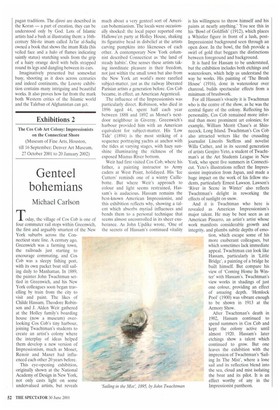Exhibitions 1
Vetrange et le merveilleux en terres d'Islam (Louvre, Paris, till 23 July)
Winged horses, fiery haloes
Nicholas Powell
ASyrian friend who accompanied the Pope round the Umayyad mosque in Damascus a few weeks ago was very disappointed that John Paul II neither visited Saladin's tomb nearby nor asked forgiveness for the Crusades — His Holiness had, after all, my friend remarked, been asking forgiveness of virtually everybody else recently.
About as tenacious a source of misunderstanding between the West and the Middle East as the Crusades is the idea that Muslims, as if they were all Calvinists, and Buddha-bashers to a man, have always imposed a blanket ban on images. Organised by the Louvre's Islamic art department and containing exhibits from eight European museums, L'Etrange et le merveilleux en tetres &Islam (The strange and wonderful in Islamic lands'), a magical and very eclectic exhibition, nobbles that legend and opens a window on the importance of the fanciful and the fantastic in a religion often assumed to be austere and supremely rational.
Housed in the Hall Napoleon underneath the Louvre's pyramid entrance until 23 July, the show commences with an evocation of the Arabian Nights, that supreme source of Western fantasising about Eastern
lasciviousness. The Frenchman Antoine Galland provided the first-ever translations of these tales — originally oral and first transcribed in Arabic during the 13th century — between 1704 and 1712. With the poetry and the saucy bits left out and written up in a style aimed to please the rarefied taste of the French aristocracy, 'Les Mille et Une Nuits' was a tremendous hit first with the court of Louis XIV and then with the rest of Europe.
The Louvre is displaying Arab and Turkish manuscripts and the work of modern European illustrators. Leon Carre's pictures for a 12-volume edition in 1926 featured objects which were already in the Louvre. Several, as diverse as a 19th-century French reproduction of a mosque lamp, a 14th-century tile from Samarkand and a 12th-century Persian candlestick, are on show alongside Carre's pictures.
A constant inspiration for Islamic artists, as the next room shows, was Aja'ib alMakhluqat (The marvels of created things'). Written during the 13th century by the Persian-based Arab astronomer, geologist and mineralogist Al-Qazwini, it describes not only the structure of the heavens, from constellations to angels, but also the geography of the earth and the animals and monsters, humans and giants thereon, Whatever the precision of Al-Qazwini's prose, illustrators gave free rein to their imaginations. Depicted by a Persian artist in the 15th century as something close to the Chinese dragon, all scales, flailing limbs and fanged human head, Al-Qazwini's 'sea monster' was cast as a mix between a dog and a giant squid in a manuscript produced 100 years later.
In his descriptions of real species of birds, Al-Qazwini confidently included the phoenix and the two-headed eagle. Three of the former are to be found, tails spread, swooping round the inside of a 14th-century Persian bowl, accompanied by a hadith of the Prophet explaining that they too were created by God. Particularly popular in Spain, the two-headed eagle, meanwhile, features on a fragment of 12th-century silk (a charm to ease labour pains) and was, around the same time, a common decorative feature in Turkish architecture.
From more ancient Mediterranean sources, the Islamic world also adopted the sphinx, the winged horse and the harpy, of which it developed several sub-species, male and female: all were to inspire potters and weavers. Probably an import from China, the unicorn was continually mixed up with the rhinoceros, and a single word, karkaddan, existed for both. Feline in appearance and spotted when pursuing an elephant (its traditional enemy) on a 13th-century Iranian wall tile, the unicorn was later depicted as clovenhoofed and with a body resembling that of an antelope. A symbol of evil, the beast is bloodily overcome by the hero Gushtasp in a late-15th-century Persian manuscript of Shahnama, 'The Book of Kings'.
Many kinds of devils of varying degrees of toxicity swarmed into the Islamic world from pagan traditions. The djinni are described in the Koran — a part of creation, they can be understood only by God. Lots of Islamic artists had a bash at illustrating them: a 16thcentury Shi-ite imam called Ja'far al-Sadiq owned a book that shows the imam Rida (his veiled face and a halo of flames indicating saintly status) snatching souls from the grip of a hairy orange devil with bells strapped round its legs and dangling between its ears.
Imaginatively presented but somewhat busy, shooting as it does across centuries and indeed continents, the Louvre exhibition contains many intriguing and beautiful works. It also proves how far from the mark both Western critics of the Islamic world and the Taleban of Afghanistan can get.











































































 Previous page
Previous page